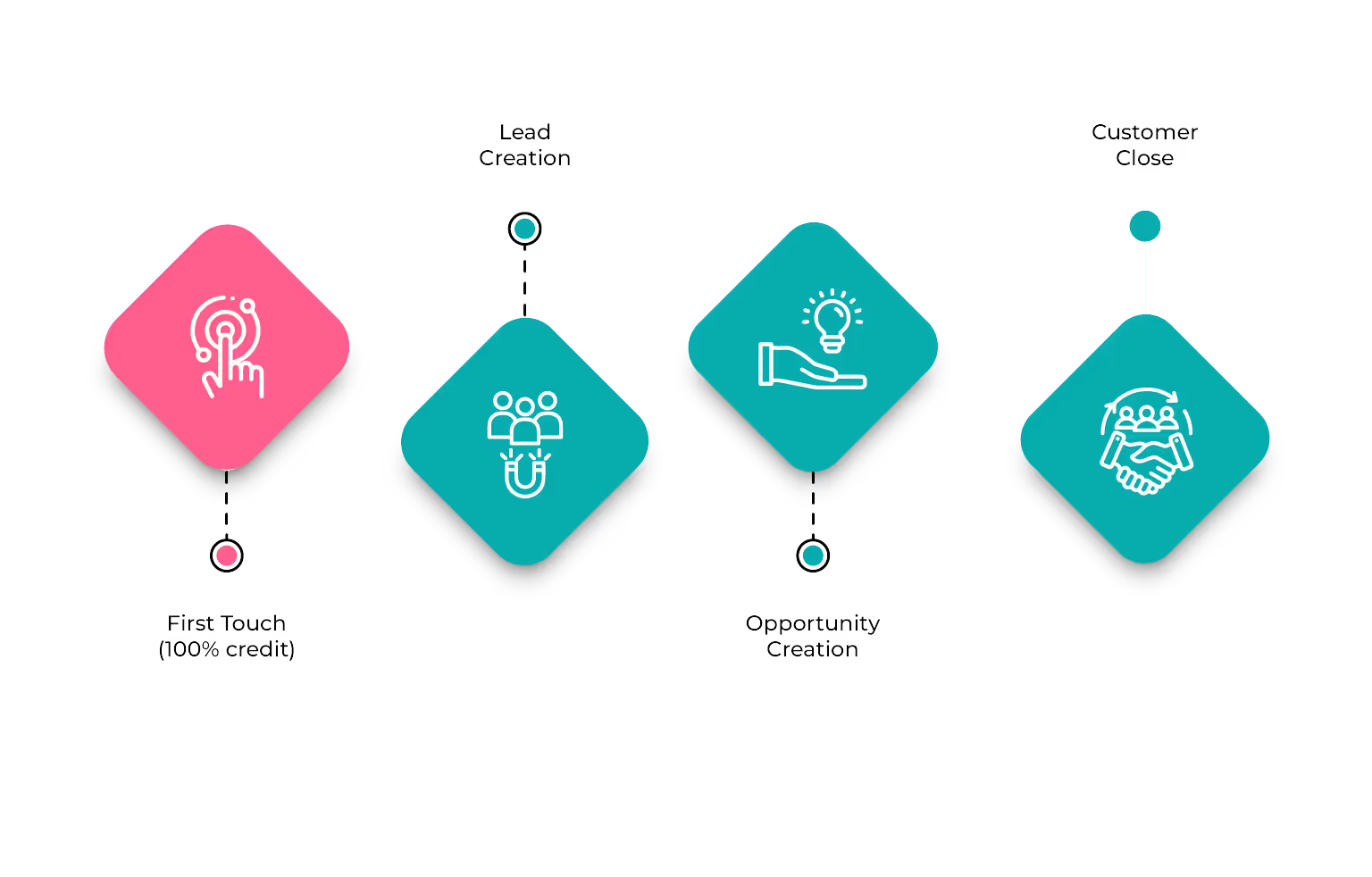
Blog
Unlocking the Power of Revenue Attribution: Maximizing Growth and Decision-Making
August 7, 2023


Key Insights
How important is data in the decision-making process?
In an article titled The Advantages Of Data-Driven Decision-Making, Tim Stobierski points out that it's through data that you verify, understand, and quantify.
In the article, he refers to a PwC survey that found that organizations heavily relying on data are three times more likely to see significant improvements in decision-making compared to those that don't.
These studies show how today's business landscape demands data-driven strategies to achieve optimal marketing and sales initiatives.
So how can these data-driven tools be incorporated into your business operations to optimize the marketing and sales initiatives?
That is where revenue attribution comes into relevance.
This article takes you through understanding revenue attribution, its relevance in your business operations, various types of attributions, and the challenges and limitations it poses.
So scroll down for more insights.
What is Revenue Attribution?
Revenue attribution or marketing attribution is a crucial concept in marketing and sales analytics through which marketers analyze and understand the effectiveness of their marketing campaigns.
Companies will invest in running their marketing activities on multiple channels like Google, Facebook, LinkedIn, etc.
Through revenue attribution, they can examine the revenue before and after a marketing campaign and identify the sources or touchpoints that contribute to generating revenue for a business.
The calculation considers factors such as the time taken for a sale to occur after the campaign, the number of orders made during the campaign, and so forth.
Businesses can use this tool to determine which marketing channels, campaigns, and customer touchpoints had the most impact on driving sales and contributing to their overall business success.
The data gathered through this evaluation helps companies to make more informed decisions, plan effective marketing strategies, and allocate their budget judiciously.
The Importance of Revenue Attribution
Getting feedback for the work you do will always help you to understand your weak points and work on improving. Revenue attribution also plays a similar role.

- Revenue attribution analysis helps gain valuable data and insights on the effectiveness of the marketing campaigns initiated. This analysis enables businesses to understand which specific marketing channels and touchpoints contribute most significantly to revenue generation, allowing for informed adjustments and optimization of revenue strategy examples to enhance overall campaign performance.
- Understanding how well your target audience has received your ads will help in making data-driven decisions to optimize the marketing campaigns.
- Evaluating the effectiveness of marketing campaigns and channels in bringing in sales and driving revenue will help companies allocate their budget judiciously.
- In addition, it helps in better use of resources for the most profitable activities ensuring a better return on investment.
- Revenue Attribution helps in better aligning marketing and sales teams and helps improve their collaboration for driving business growth by providing valuable insights into the effectiveness of different sales team roles and their contributions to overall revenue generation.
Hence, monitoring customer behavior and tracking sales and revenue changes is crucial for optimizing marketing strategies and enhancing overall performance, leading to increased growth and revenue for enterprises.
For more information on improving sales effectiveness, The Ultimate Guide to Improving Sales Effectiveness: Tips and Tricks

Types of Revenue Attribution Models
Various attribution models are used to distribute credit to different marketing channels. Broadly revenue attribution models are divided into two: single-touch models and multi-touch models.
- Single-touch model
In a single-touch model, only one factor gets credited for the sales conversion. The most common single-touch attributes are the first-touch attribution or the last-touch attribution.
In the first-touch point, the credit of the sales is given to the first point of interaction. It mostly focuses on the top of the funnel, especially the digital ads.
Following a first-touch model helps in understanding the effectiveness of your ads or the channels in which they are implemented.
In the last touch point, the focus is on the last point of interaction. Since it focuses on the bottom of the funnel, the data acquired will be more accurate as it's a narrow area under analysis.

- Multi-touch model
A multi-touch attribution model analyzes each factor that influenced the conversion throughout the customer journey. Since it leaves no stone turned, a multi-touch model provides a holistic idea about marketing effectiveness.
Some of the multi-touch models are the Linear attribution model, U shape attribution, W shape attribution, full path attribution model, etc.
While a linear model gives equal credit to each factor, a U shape model gives more emphasis on the first and last touch.
On the other hand, a W-shaped model and the full path attribution model not just give credit to the customer touchpoints but also focus on the transition between these points. In the context of a multi-touch model, understanding the diverse customer journey becomes essential, enabling the design of more tailored sales campaigns that resonate with different touchpoints.

In the last touch point, the focus is on the last point of interaction. Since it focuses on the bottom of the funnel, the data acquired will be more accurate as it's a narrow area under analysis.
Though revenue attribution is an effective way to determine the success of your marketing initiatives, it is also not a straightforward process to accomplish.
Let’s look at the challenges of revenue attribution.
Challenges and Limitations of Revenue Attribution
As effective a tool as it is in data-driven decision-making and insightful operations, revenue attribution reports are not without challenges. So, here are a few you need to know:
- The accuracy of the attribution depends on the quality and completeness of the data collected.
- Even in a single or multiple touchpoint model, determining the accuracy of the data collected is difficult.
- A customer can come across your brand or product in various ways. Hence, crediting only a single touchpoint means losing sight of other factors that contributed.
- In most cases, a first touch point will not drive a customer to convert. It requires a consistent push from various other players.
- Similarly, crediting the last touch point puts a blind eye on all other factors that lead the prospect to the bottom of the funnel.
- Even if you choose a multi-touch attribution to understand which player made the larger impact, it requires a scrutinized process to get the data accurately.
To read more on sales challenges and overcoming it, check How to Overcome 5 Top Sales Planning Challenges with Sales Performance Management
Conclusion
Revenue Attribution reports play a key role that allows companies to understand the various channels and touchpoints that contribute to the company's overall revenue generation. Leveraging revenue intelligence solutions, it helps companies determine which activities or campaigns impact their revenue streams and provide a more accurate view of their marketing performance.
It is a prime example of the impact a data-driven decision can have on your business operations. Understanding the significance it can have to enhance your business, an increasing number of organizations incorporate data-driven solutions in their everyday tasks.
In a sales organization, the inevitable tools are incentive compensation management and sales performance management solutions.
Kennect builds, runs, and automates your incentive compensation plans to create transparency and achieve operational efficiency. For more information, Book A Demo Now!
ReKennect : Stay ahead of the curve!
Subscribe to our bi-weekly newsletter packed with latest trends and insights on incentives.
Thank you! Your submission has been received!
Oops! Something went wrong while submitting the form.
Your data is in safe hands. Check out our Privacy policy for more info











